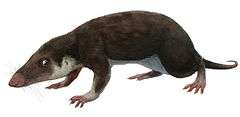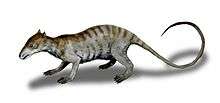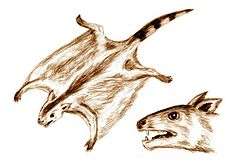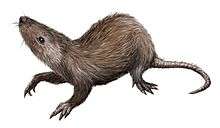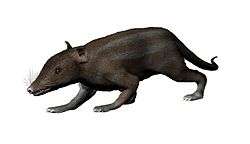Tillodontia
Tillodontia is an extinct suborder of eutherian mammals known from the Early Paleocene to Late Eocene of China, the Late Paleocene to Middle Eocene of North America where they display their maximum species diversity, the Middle Eocene of Pakistan, and the Early Eocene of Europe. Leaving no descendants, they are most closely related to the pantodonts, another extinct group. The tillodonts were medium- to large-sized animals that probably feed on roots and tubers in temperate to subtropical habitats.[1]
| Tillodontia | |
|---|---|
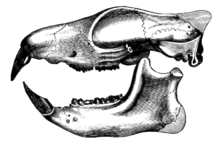 | |
| Tillodon skull | |
| Scientific classification | |
| Kingdom: | |
| Phylum: | |
| Class: | |
| Order: | |
| Suborder: | Tillodontia |
| Genera | |
|
See text | |
Description
Tillodonts had rodent-like incisors, clawed feet and blunt, cusped teeth. They were mostly medium-sized animals, although the largest of them (such as Trogosus) could reach the size of a large bear.[2]
The cranium ranged in length from 5 to 37 cm (2.0 to 14.6 in) and had a characteristic elongated rostrum, an elongated mandibular symphysis, and a shortened basicranial region. The second upper and lower incisors are large in most species, the first upper and lower premolars are small or absent, the fourth upper and lower premolars are molariform (molar-like).[1]
When Marsh first named and described the tillodonts, he explained:[3]
These animals are the among the most remarkable yet discovered in American strata, and seem to combine characters of several distinct groups, viz: Carnivores, Ungulates, and Rodents. In Tillotherium (=Trogosus), the type [specimen] of the order, the skull has the same general form as in the Bears, but its structure resembles that of Ungulates. The molar teeth are of the ungulate type, the canines are small, and in each jaw there is a pair of large scalpiform incisors faced with enamel, and growing from persistent pulps, as in Rodents.
When naming his new "pachyderm" species Trogosus castoridens ("beaver-toothed gnawing-hog"), Leidy added that it was a fossil "which would appear to have pertained to the stock from which diverged the Rhinoceros and Mastodon, the Peccary, and perhaps the Beaver."[4]
Classification
Franchaius from the early Eocene of Europe, Benaius, Lofochaius, Meiostylodon, and Huananius from the early Paleocene of China, and Yuesthonyx from the late Paleocene of China are primitive forms. Interogale from the late Paleocene of China, and Anchilestes probably from the middle Paleocene of China, were once assigned to Anagalida, but may also be primitive tillodonts.[5]
The monophyly of the subfamily Trogosinae is unchallenged, but Esthonychines most likely includes the ancestors of Trogosinae and therefore is probably paraphyletic. Tillodontia is mostly known from dentaries and teeth. The cranium is best known from Trogosinae and the postcranium from Trogosus.[6]
Azygonyx and Esthonyx from North America, Franchaius and Plesiesthonyx from Europe, and possibly Basalina from Pakistan (to the extent anything can be said about it) and an unassigned specimen from India are all morphologically closely related but obviously geographically quite widespread. In contrast, Asian tillodonts tend to be smaller and less derived. This possible link between specimens from the Indian subcontinent and those from Europe and America adds evidence to a faunal interchange between these continents during the early Eocene.[7]
Suborder Tillodontia[8]
- Genus †Azygonyx (Gingerich 1989), dentary, postcranial fragments
- Genus †Basalina (Dehm & Oettingen-Spielberg 1958), poorly preserved jaw fragment with incomplete cheek tooth
- Genus †Benaius (Wang & Jin 2004), left lower jaw
- Genus †Dysnoetodon (Zhang 1980), maxilla and lower jaw
- Family †Esthonychidae (Cope 1883) (Syn. Anchippodontidae, Tillotheriidae)
- Genus †Adapidium (Young 1937), right lower jaw
- Subfamily †Esthonychinae (Zittel & Schlosser 1911)
- Genus †Esthonyx (Cope 1874), lower mandibles, teeth
- Genus †Megalesthonyx (Rose 1972), left mandible, teeth, feet bones
- Subfamily †Trogosinae (Gazin 1953) (Syn. Anchippodus)
- Genus †Tillodon (Gazin 1953), skull
- Genus †Trogosus (Leidy 1871) (Syn. Tillotherium), skull, lower jaws, teeth, vertebrae, ilium, limb bones, feet bones
- Genus †Franchaius (Baudry 1992; synonymized with Plesiesthonyx, Hooker 2010), less than 20 isolated teeth[7]
- Genus †Higotherium (Miyata & Tomida 1998),[9] fragmentary right mandible, teeth
- Genus †Interogale (Huang & Zheng 1983), well-preserved mandible
- Genus †Kuanchuanius (Chow 1963), partial mandible, teeth
- Genus †Lofochaius (Chow et al. 1973), poorly preserved skull with few teeth
- Genus †Meiostylodon (Wang 1975), three isolated teeth
- Genus †Plesiesthonyx (Lemoine 1891), isolated molars
- Genus †Plethorodon (Huang & Zheng 1987), partial skull with upper cheek teeth
- Genus †Simplodon (Huang & Zheng 2003), right upper jaw with cheek teeth
- Family †Yuesthonychidae (Tong, Wang & Fu 2003)
- Genus †Yuesthonyx (Tong, Wang & Fu 2003), left mandibles, partial skull, teeth
Notes
- Lucas & Schoch 1998, p. 268
- "Tillodontia". Answers.com. Retrieved 24 July 2013.
- Marsh 1875, p. 221
- Leidy 1871, p. 115
- Rose 2006, p. 113
- Rose 2006, p. 111
- Rose et al. 2009, pp. 353–4
- Tillodontia: Relationships in the Paleobiology Database Retrieved July 2013.
- "†Higotherium". Taxonomicon. Retrieved 24 July 2013.
References
- Baudry, Mylène (1992). "Les Tillodontes (Mammalia) de l'Eocène inférieur de France". Bulletin du Muséum National d'Histoire Naturelle, Section C. 14 (2): 205–243.CS1 maint: ref=harv (link)
- Chow, Minchen M. (1963). "Tillodont Materials from Eocene of Shantung and Honan" (PDF). Vertebrata PalAsiatica (in Chinese and English). 7 (2): 97–104. Retrieved 24 July 2013.CS1 maint: ref=harv (link)
- Chow, Minchen M.; Chang, Yu-ping; Wang, Ban-yue; Ting, Su-yin (1973). "New Mammalian Genera and Species from the Paleocene of Nanhsiung, N. Kwangtung" (PDF). Vertebrata PalAsiatica (in Chinese and English). 11 (1): 31–35. Retrieved 24 July 2013.CS1 maint: ref=harv (link)
- Cope, E. D. (1874). "Report upon vertebrate fossils discovered in New Mexico, collected in 1874". In Wheeler, George (ed.). Annual Report Upon the Geographical Explorations and Surveys West of the One Hundredth Meridian, in California, Nevada, Utah, Arizona, Colorado, New Mexico, Wyoming, and Montana, Appendix FF. Washington: Government Printing Office. pp. 118–120. Retrieved 24 July 2013.CS1 maint: ref=harv (link)
- Cope, E. D. (1883). "On the mutual relations of the bunotherian Mammalia". Proceedings of the Academy of Natural Sciences of Philadelphia. 35: 77–83. Retrieved 24 July 2013.CS1 maint: ref=harv (link)
- Dehm, Richard; Oettingen-Spielberg, Therese zu (1958). Paläontologische und geologische Untersuchungen im Tertiär von Pakistan. 2. Die mitteleocänen Säugetiere von Ganda Kas bei Basal in Nordwest-Pakistan. Abhandlungen / Neue Folge, 91. Munich: Beck. OCLC 163296508.CS1 maint: ref=harv (link)
- Gazin, C. L. (1953). "The Tillodontia : an early tertiary order of mammals". Smithsonian Miscellaneous Collections. 121 (10): 1–110. OCLC 459282832. Retrieved 24 July 2013.CS1 maint: ref=harv (link)
- Gingerich, P. D. (1989). "New earliest Wasatchian mammalian fauna from the Eocene of northwestern Wyoming: composition and diversity in a rarely sampled high-floodplain assemblage". University of Michigan Papers on Paleontology. 28: 1–97. Retrieved 24 July 2013.CS1 maint: ref=harv (link)
- Hooker, J. J. (2010). "The mammal fauna of the early Eocene Blackheath Formation of Abbey Wood, London". Monograph of the Palaeontographical Society London. 165 (634): 1–162. Retrieved 24 July 2013.CS1 maint: ref=harv (link)
- Huang, Xueshi; Zheng, Jiajian (1983). "A New Anagalid from Upper Paleocene of Nanxiong Basin, Guangdong" (PDF). Vertebrata PalAsiatica (in Chinese and English). 21 (1): 59–63. Retrieved 24 July 2013.CS1 maint: ref=harv (link)
- Huang, Xueshi; Zheng, Jiajian (1987). "A New Pantodont-like mammal from the Paleocene of Chienshan Basin, Anhui" (PDF). Vertebrata PalAsiatica (in Chinese and English). 25 (1): 20–31. Retrieved 24 July 2013.CS1 maint: ref=harv (link)
- Huang, Xueshi; Zheng, Jiajian (2003). "A tillodont-like mammal from the Middle Paleocene of Qianshan Basin , Anhui , China" (PDF). Vertebrata PalAsiatica. 41 (2): 131–136. Retrieved 24 July 2013.CS1 maint: ref=harv (link)
- Leidy, J. (1871). "Remains of extinct mammals from Wyoming". Proceedings of the Academy of Natural Sciences. 23: 113–116. Retrieved 24 July 2013.CS1 maint: ref=harv (link)
- Lemoine, M. (1891). "Étude d'ensemble sur les dents des mammifères fossiles des environs de Reims". Bulletin de la Société Géologique de France. 3rd. 19: 263–290 (276). Retrieved 24 July 2013.CS1 maint: ref=harv (link)
- Lucas, S. G.; Schoch, R. M. (1998). "Tillodontia". In Janis, Christine Marie; Scott, Kathleen Marie; Jacobs, Louis L. (eds.). Evolution of Tertiary Mammals of North America: Terrestrial carnivores, ungulates, and ungulatelike mammals. Cambridge University Press. pp. 268–273. ISBN 9780521355193.CS1 maint: ref=harv (link)
- Marsh, O. C. (1875). "New Order of Eocene Mammals". American Journal of Science. 9: 221. Retrieved 24 July 2013.CS1 maint: ref=harv (link)
- Miyata, Kazunori; Tomida, Yukimitsu (1998). "A new tillodont from the early Middle Eocene of Japan and its implication to the subfamily Trogosinae (Tillodontia : Mammalia)" (pdf). Paleontological Research. 2 (1): 53–66. Retrieved 24 July 2013.CS1 maint: ref=harv (link)
- Rose, Kenneth D. (1972). "A New Tillodont from the Eocene Upper Willwood Formation of Wyoming" (PDF). Postilla. Peabody Museum of Natural History. 155. OCLC 7337187. Retrieved 24 July 2013.CS1 maint: ref=harv (link)
- Rose, Kenneth D. (2006). The beginning of the age of mammals. Baltimore: JHU Press. ISBN 0801884721.CS1 maint: ref=harv (link)
- Rose, Kenneth D.; Rana, Rajendra S.; Sahni, Ashok; Kumar, Kishor; Singh, Lachham; Smith, Thierry (2009). "First Tillodont from India: Additional Evidence for an Early Eocene Faunal Connection between Europe and India?". Acta Palaeontologica Polonica. 54 (2): 351–355. doi:10.4202/app.2008.0067. Retrieved 24 July 2013.CS1 maint: ref=harv (link)
- Tong, Yong-Sheng; Wang, Jing-Wen; Fu, Jing-Fang (2003). "Yuesthonyx, a new tillodont (Mammalia) from the Paleocene of Henan" (PDF). Vertebrata PalAsiatica. 41 (1): 55–65. Retrieved 24 July 2013.CS1 maint: ref=harv (link)
- Wang, Ban-yue (1975). "Paleocene mammals of Chaling Basin, Hunan" (PDF). Vertebrata PalAsiatica (in Chinese). 13 (3): 154–162. Retrieved 24 July 2013.CS1 maint: ref=harv (link)
- Wang, Y.-Q.; Jin, X. (2004). "A new Paleocene tillodont (Tillodontia, Mammalia) from Qianshan, Anhui, with a review of Paleocene tillodonts from China" (PDF). Vertebrata PalAsiatica (in English and Chinese). 42 (1): 13–26. Retrieved 24 July 2013.CS1 maint: ref=harv (link)
- Young, C. C. (1937). "An early Tertiary vertebrate fauna from Yuanchü". Bulletin of the Geological Society of China. 17 (3–4): 413–438. doi:10.1111/j.1755-6724.1937.mp173-4012.x.CS1 maint: ref=harv (link)
- Zhang, Yu-ping (1980). "A New Tillodont-Like Mammal from the Paleocene of Nanxiong Basin, Guangdong" (PDF). Vertebrata PalAsiatica (in Chinese and English). 18 (2): 126–30. Retrieved 24 July 2013.CS1 maint: ref=harv (link)
- Zittel, K. A., von; Schlosser, M. (1911). Grundzüge der Paläontologie (Paläozoologie). 2. Vertebrata. Munich. OCLC 312682921.CS1 maint: ref=harv (link)
